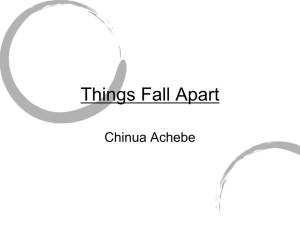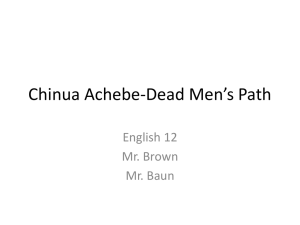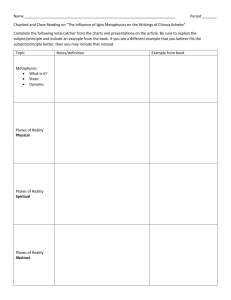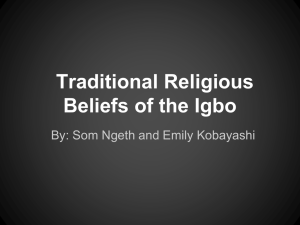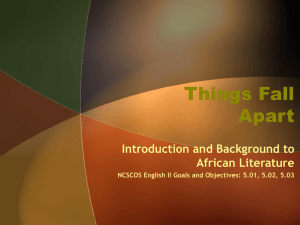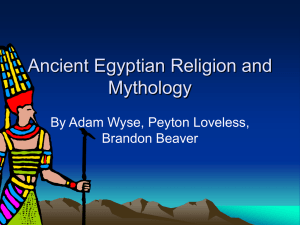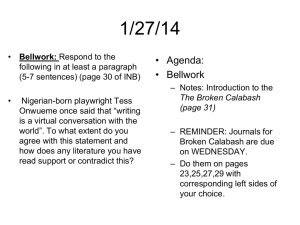The Inventor of Ogam - Catherine Acholonu Research Center for
advertisement
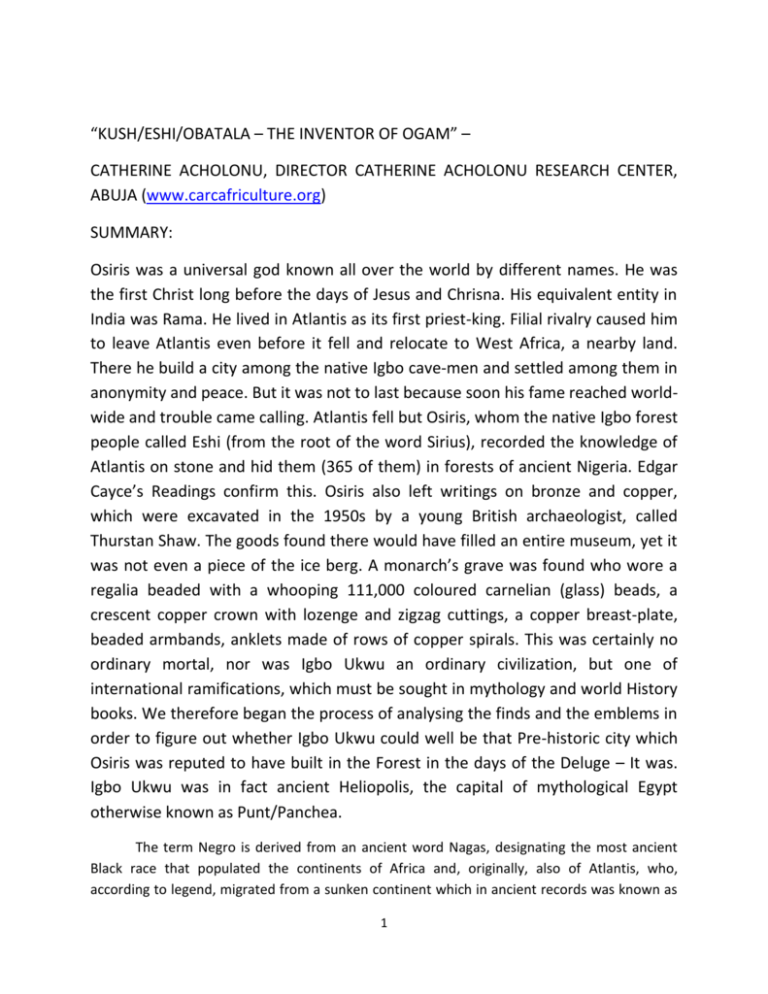
“KUSH/ESHI/OBATALA – THE INVENTOR OF OGAM” – CATHERINE ACHOLONU, DIRECTOR CATHERINE ACHOLONU RESEARCH CENTER, ABUJA (www.carcafriculture.org) SUMMARY: Osiris was a universal god known all over the world by different names. He was the first Christ long before the days of Jesus and Chrisna. His equivalent entity in India was Rama. He lived in Atlantis as its first priest-king. Filial rivalry caused him to leave Atlantis even before it fell and relocate to West Africa, a nearby land. There he build a city among the native Igbo cave-men and settled among them in anonymity and peace. But it was not to last because soon his fame reached worldwide and trouble came calling. Atlantis fell but Osiris, whom the native Igbo forest people called Eshi (from the root of the word Sirius), recorded the knowledge of Atlantis on stone and hid them (365 of them) in forests of ancient Nigeria. Edgar Cayce’s Readings confirm this. Osiris also left writings on bronze and copper, which were excavated in the 1950s by a young British archaeologist, called Thurstan Shaw. The goods found there would have filled an entire museum, yet it was not even a piece of the ice berg. A monarch’s grave was found who wore a regalia beaded with a whooping 111,000 coloured carnelian (glass) beads, a crescent copper crown with lozenge and zigzag cuttings, a copper breast-plate, beaded armbands, anklets made of rows of copper spirals. This was certainly no ordinary mortal, nor was Igbo Ukwu an ordinary civilization, but one of international ramifications, which must be sought in mythology and world History books. We therefore began the process of analysing the finds and the emblems in order to figure out whether Igbo Ukwu could well be that Pre-historic city which Osiris was reputed to have built in the Forest in the days of the Deluge – It was. Igbo Ukwu was in fact ancient Heliopolis, the capital of mythological Egypt otherwise known as Punt/Panchea. The term Negro is derived from an ancient word Nagas, designating the most ancient Black race that populated the continents of Africa and, originally, also of Atlantis, who, according to legend, migrated from a sunken continent which in ancient records was known as 1 Mu or Lemuria. Nagas are called the Lords of Fire and their symbol is the serpent or the firespitting serpent, otherwise called the dragon. In the ancient Tibetan epic story of the Birth of the Universe - Stanzas of Dzyan the “The Sons of Fire” are called “the Instructors” of the Sons of God and their emblem is “the Dragon of Wisdom”- the Mother whose nature is the spiralling whirlwind - the Swastika. Stanzas 11-12 of this timeless Tibetan epic hidden in the ancient caverns of the Himalayas, translated in part by Helen Blavatsky (The Secret Doctrine), speaks about “the First Great Waters” before the Deluge of Noah: The first great waters came, they swallowed the seven great islands. All holy were saved, the unholy destroyed… Few remained, some yellow, some brown and black, and some red remained. The Fifth produced from the holy stock remained; it was ruled over by the first Divine Kings … the serpents who descended, who made peace with the Fifth, who taught and instructed it…(published Online under the title “The Stanzas of Dzyan, reprinted from The Secret Doctrine by Helen Blavatsky”). The fifth race was a collective term for identifying all those who were saved from the first Flood. Our interest here is that the Serpents of Wisdom “descended” (which means that they 'took bodily form') from their otherwise ethereal state, and allowed themselves to be born among these remnants of mankind who needed teaching in survival skills. The reference to the serpents who descended, reminds us of Ikom oral tradition (Ikom is a local community in Nigeria) record/reference to the husband of Shishe (the monolith which they call mother of mankind, their equivalent of Eve) as being “the first man that dropped/fell” (which means ‘became physical/fell from divine grace’); and the reference to the Serpents as instructors and Sons of Fire, connect them to Nag Hammadi Scriptures’ reference to Eve as the serpentinstructor of Adam. These serpents were “the First Divine Kings” of the earth, the same ones whom the Stanzas describe as “the Sons of Fire, the Instructors” (cf. Brandsbutt Ogam stone, Aberdeenshire (plate 1: Titus Didactica, Online Ogam Listing, No. 12, see Acholonu’s Translation of this Ogam inscription and linking it and other Ogams to the lost culture of the Nagas Priest-kings published in Christine Pellech Website Migrations and Diffusions). These Sons of Fire are connected to Eve the instructor/serpent and are part and parcel of the Consciousness of the One Son whom the Tibetan Stanzas of Dzyan calls “The Radiant Child … the unparalleled refulgent Glory- Bright Space, Son … who emerges from the Depths of the great Dark Waters ... He shines forth as the Sun, he is the Blazing Divine Dragon of Wisdom” (The Stanzas of Dzyan, from Helen Blavatsky, The Secret Doctrine, excerpts published Online). Here is evidence, hidden from Western records and scriptures that the metaphor for the nature of the Son of God, the Christ, is Naga/the Negro-the Fire-breathing Serpent, otherwise called the Dragon of Wisdom. Certainly there is need to ask ourselves questions at this point. How did the serpent become the devil and the enemy of God and of the Christ? 2 The Grand Conspiracy to De-throne the Serpents of Wisdom: Laird Scranton in The Science of the Dogon (2006) observed that in Egypt as in Dogon mystery traditions, the serpent motif is associated with the Sirius constellation of stars which is said to be the seat of the god-government of our universe. The god-stars of Sirius exert every influence on our solar system and all gods are said to be accountable to the Elders' Council sitting in the Sirius star system! Much has been written on Sirius and its influence on the civilizations of the world, especially Egypt and we have no intention of digressing into that. Our interest however, is that the Naga Serpents of Wisdom are said to be ministers from Sirius whose mission is to save earth from those renegade gods whom the Hebrew Bible calls ‘Nephilim’ and make it a paradise for god-men. At the height of the wars with the Nephilim, these god-men (some say ‘extraterrestrials’) were said to have taken refuge underground and created labyrinthine palaces there while the Nephilim and their followers took over the earth's surface. Soon the Nephilim devised a plan to cast the serpents in the mould of evil along with their black complexion, their Abzu/Nether-world abode and their underground habitations became the location of hell. This lie was craftily woven into the fabric of the religious beliefs they gave to gullible humanity, while Truth was forced to go underground and was coded as “forbidden knowledge” before the religions of the world. How was this achieved? R. T. Rundle Clark quoted in Myth and Symbol in Ancient Egypt “an Egyptian myth… similar to the Dogon story of the killing of the serpent that tells about the turn around of the attitude toward the formerly revered serpents from worship to vilification” (Laird Scranton, 2006, p. 182). Randle Clark’s revelations in this regard confirm our earlier suggestion that Ra sojourned in Igbo land during his 1,000 year long exile as Eri, and that when his attempt to enforce his rule over the sons of the Goddess failed, he plotted a coup de grace against their leader Khem/Obatala/Ham/Rama and against their Mother, the Great Goddess. We quote from R. T. Rundle Clark: This god (i.e. Atum hidden name of Ra) … [summoned Geb to himself]. When Geb [his son] had come to him, he said: 'Take care of the serpents which are [under] you. Behold they showed respect to me while I was down there [in the Abzu]. But now you have learned their nature. Proceed to the place where Father Nun is, tell him to keep guard over the serpents, whether in the earth or in the water… Now their lot is to be in the world forever. But beware of the magical spells which their mouths know, for Hike: Power … is therein. But knowledge is in you. It will not come about that I, in my greatness will have to keep guard over them as I once did, but I will hand them over to your son Osiris so that he can watch over their children and the hearts of their 3 fathers be made to forget. Thus advantage can come from them out of what they perform for love of the whole world (as in the example of Jesus), through the magical power that is in them. (Clark, 1995, p. 243-244). Indeed Osiris as the Christ revealed in The Nag Hammai Scriptures (“Three Forms of First Thought” that he allowed himself to be born among the sons of chaos “I hid in them until I revealed myself to my brethren”. Ra and Geb must have thought that Osiris was truly one of them and gave him charge over the African Serpent Nagas of Igbo land (Igbo means ‘Forest People’). But Osiris soon made his home there and taught these cave men whom Thoth in The Emerald Tablets of Thoth the Atlantean (edited by Doreal) calls “the hairy Barbarians”. This was the original Egypt of mythology and these events actually happened in mythical Punt/Panchea – an outpost and rival of Atlantis then also located off the shores of West Africa according to Plato’s Timaeus and Critias. which according to our findings was located in West African in a place then and now called Biafra in Old Maps of Africa. The time was 12,000 to 10,000 B.C. by Egyptian records (see the works of Zechria Sitchen and Edgar Cayce’s, Cayce on Atlantis for dating). Osiris was eventually exiled from Atlantis. The detail of this part of his life story is told in greater detail in the Hindu Ramayana epic by Valmiki, for Osiris/Khem was the same person whom the Dravidian Indians call Rama or Yama, the god of Death. As Khem, known in the Bible as Ham/ Osiris was said to have built the first post-Deluge City in the forest (The Hebrew Book of Jubilees), so was Rama said to have built a city in the forest that was visited by Masters/Shaman from all over the world. Greek Historians Herodotus, Diodorus and Homer say that Panchea (Western Ethiopia) was a dwelling place of gods and holy men, inhabited by dwarfs who were literate and were all wizards. Their dressing was raffia and woven cloth, died blue. Raffia skirt was a trademark of Obatala/Nigerian Osiris (see Plate 3). They bore facial scarifications (plate 3b, 4a, 4b) and horse-tails as symbols of nobility. ALL THESE, WIHOUT ANY EXCEPTION, WERE FOUND IN PRE-COLONIAL IGBO CULTURE. In fact the Igbo ancestral god, Eshi, whom the Yoruba call Obatala was known by the X-shaped facial scarificaion (plate 3b; X is the mark of the Christ in the Middle East and of the letters Kh (Khem) /Ch (Christ/Chi) in Egypt, in Ogam and in Christendom) and by the raffia cloth of palm fronds, for in Egypt and in ancient Nigeria, Osiris/Eshi/ Obalata was the god associated with the palm tree – the tree of oracles (plate 3,3b). IGBO GOD, ESHI/OSIRIS - THE INVENTOR OF OGAM: Eshi, whom the Yoruba call Obatala was known, even among the Yoruba tribe of Nigeria, by his facial scarification, which is captured by Phillips Stephens in his book The Stone Images of Esie (plate 3, 3b; 1978). In previous articles on the subject of Ogam, we have drawn similarities between Ogam and Igbo Ichi facial scarification. But here in this image is clearly preserved 4 evidence that Ogam was an invention of the Igbo god and ancestor Eshi/Obatala, whom we have identified as Osiris/Khem/Kush in our three books under reference. The god is bearing the entire lexicon of Ogam engraved on his face! His full face is cut up with exactly five double crossing slanting lines as well as five straight lines above his lips, across his lips and on his jaws! These lines contain the full Ogam orthography made up of one to five slanting lines and one to five straight lines arranged to the right, to the left and across an axis (the axis in this case is the center ridge of the face as well as the lips). The lips represent the axis, while the lines below and above them represent the Ogam horizontal lines facing right and facing left (if the face is turned to the side; plate 3c, item A). The lines hatching across the nose represent the slanting Ogam lines. Five lines in Ogam whether straight or slanting, to the right, or the left and across the central axis give the following letters Kw/Kh/Yi/R/N and contain all the other letters (four lines, three lines, two lines and single lines (see item H, plate 3c). The short lines across the lips are the vowel notches A, O, U/W, E, I. The lines which are four in number give the letters E/S/Z/SS/K. Where these lines cross, they form X-shaped crosses and cross-hatching – X being the symbol of the Christ and the quadrangles created by the hatching are symbols of the Mother/Goddess. Both the X, the quadrangle, the cross hatching and the square all of which are formed in the scarified face of the god, are all Ogam letters (see item G, Plate 3c). All the letters formed by the lines numbering five and four are Igbo/Egyptian words referring to the god Eshi/Kush/Osiris as the son of God and to the Kwa as sons of God and Priest-kings: Kwa, Khem, Iyi, Ora, Ra, Ana, Naga, Eze, Eshi, Isse. From the letter Kw is formed the word Kwa – the Mega-tribal name of the Igbo and their kin the Yoruba, Benin, Ashanti and others all of who were part of the Osiris civilization. From the letter Kh is formed the word Khem – the Egyptian name of Osiris/Eshi. From the letters Yi/J is formed the Igbo word Iyi – Waters/Sea/God as the Great Sea of Being; the word Y-H-V-H (Ieue) – the Tetragram divided into four equal triangles by a central X all the four corners (see The Lost Testament) is the Hebrew symbol for God. It is derived from the X ichi of Osiris and is related to the equal-armed cross (plates 3b, 5, 6). From the letter R is formed the word Ora – Sun and its Egyptian cognate Ra (Sun god), the true title of Osiris/Khem/Eshi as a son of the Sun Sirius, usurped from him by his grandfather. The letter N is the first letter in the word Naga, but it is also the root of thye word Ana – earth, a most important entity among the Ogam writers, whom we have found to be earth-worshippers. Next come the four-line Ogam letters on the face of the god. Their sound equivalents are E and S for Eshi (Igbo name of Osiris), E and Z for Eze (Igbo for ‘Priest-king’), E and SS for Isse (Igbo intonation of ‘Amen’, which means ‘Five’! and is an allusion to Osiris/Khem whose number is five (as seen from the five concentric circles on the Khem monolith, plate 2, and the five cross lines on Obatala’s face (plate 3b), matching the five-pointed star of Egypt). K is the letter/sound associated with the Nagas (see They Lived Before Adam, 2009). The X symbol is Naga letter Ch and Kh. Chi stands for Igbo Chi (‘God/Sun/dawn’) while Kh is the root of the 5 Egyptian name of Osiris (Khem). Chi is equally the root of Ichi, Igbo name for the scarification that Obatala bears on his face (in other words of Ogam). The fact that according to our Ogam translations (number 0002, published on the Christine Pellech Website, Migrations and Diffusions), one of the Ogam stones that bears the image of a serpent actually also bears the words Eshi, is a strong evidence in favour of our thesis that it was Osiris – the Igbo god, Eshi, who created Ogam. The inscriptions on the stone under reference say, ‘I am Eshi, the serpent that swallowed its poison-ladden mother. Trap me and you trap a Frightening Destiny’! (plate 1). Ancient Egyptian Pharaohs took the prefix Eshi into their names as a mark of honour and spiritual affiliation to Osiris (as in the name of Pharaoh Isesi; the name was transplanted to the Middle East and is found in such royal titles as AshurIsh – Assyria, Ishthar, etc, along with the word Kush, Kish, which is a cognate of the local name of the monoliths Akwa Nsi – pronounced in Egyptian as Kwush/Kush – the Nigerian vernacular name of Osiris, which also implies Kwa Eshi (Osiris – the god of the Kwa). The Egyptian variant Kwush was ultimately transcribed by the Greeks as Hyksos – a clan of latter-day descendants of the followers of Osiris that left Egypt to populate the Middle and Far East, see Martin Bernal – Black Athena I, II). In the famous text of Unas, the Kwa (spelt Qa are celebrated as gods and masters of Egyptian civilization (see The Lost Testament), with Unas himself (Uno Eshi – ‘House of Eshi?)’, sounding like he was one of them. Perhaps they were the so called Shemsu Hor (Igbo Eshi ma Eso Orisa) which in Igbo and in Egyptian means ‘God-men Followers of the Way of Horus’ – the Lords who built Egyptian civilization. In They Lived Before Adam, we demonstrated Igbo roots of several Egyptian words and philosophies and will not dwell on them here for lack of space. It is important to mention that the equal-armed cross inscribed in a circle (plate 5a) which the Ogam authors celebrate as their symbol, is, according to our findings, a cartographical symbol marking the place where the Zero Latitude (the Equator) meets the Zero Longitude and is a reference to the people and the culture found in such a place. The only habitable place on the world map where the zero latitude meets the zero longitude is off the Eastern Atlantic coast of Nigeria – precisely in the area of the monoliths of Ikom (plate 5b). Incidentally the equal-armed cross inscribed in a circle is actually a NATIVE symbol of the Kwa Nigerians (plate 6) and is used in their inner mysteries by higher initiates. The fact that European Templars in their journeys around the world in search of mystical knowledge found this symbol and appropriated it, does not change the fact that its original source was among the Kwa god-men of ancient Nigeria. We believe that the use of this particular symbol by the Ogam authors in marking their stones was intended as an indication of their Nigerian/Bantu origin, because Kwa land, according to linguists, is the origin and source of the Bantu migrations that populated almost all of Sub-Saharan Africa. The city which Kush/Khem/Osiris/Rama built in the forest, was excavated by Thurstan Shaw in the 1950s. But Shaw, either because he did not perhaps know what he had dug up, or 6 because of the colonial conspiracy to keep Africans backward, did not reveal that Igbo Ukwu was a city. Before Shaw, Igbo Ukwu had been giving up buried treasures of pottery, bronze and copper. This was revealed to our research team by the natives. After Shaw, Igbo Ukwu has continued to give up buried treasures whenever a cistern is being dug in any part of the town, even to this very day. This is how we know that Igbo Ukwu was a city. Igbo Ukwu has remained outside the realm of living memory for no one has any knowledge of its existence. A city wiped from memory and from History was a lost city, a piece of mythology – in other words from ‘time immemorial’. We have done comparative analysis of Igbo Ukwu’s rich pottery and bronze inscriptions with the ancient inscriptions of the Middle East including Egypt (coupled with the nearby located monoliths and their inscriptions) and come to the conclusion that Igbo Ukwu inscriptions birthed those of the Middle East and Egypt. Besides all the metal and pottery items found in Igbo Ukwu which include the beetle, the scorpion, the serpent and serpent’s tooth (canine teeth), the ape, the fish, the inter-wined serpents, twin eggs, double headed serpents, the phoenix bird brooding twin eggs, etc., etc. are all symbols associated with Egyptian gods and mythological origins! (See The Lost Testament). Even a model of the Egyptian Benben was found in Igbo Ukwu (see The Lost Testament). Egyptian Nephilim gods eventually used their cosmic knowledge to suppress the magical powers of the sons of the Mother Goddess in Egypt and in the Middle East. Igbo land and its culture suffered the same fate as their god, Osiris. Their mother goddess religion which was planted in Egypt and the Aegean by the followers of Osiris and all over Europe, even the Americas was snuffed out totally, through massacre after massacre, the most recent being that of the Hyksos in Egypt and the Exodus that gave rise to a blooming civilization in the Aegean. The Nephilim sought to replace the religion of the goddess with that of a male god. The result was the Abraham experiment and the utter denigration and extermination of the Kwa followers of Osiris their culture, their knowledge and their true identity and place in the world. The origin of the Jews in Panchean Igbo land is the subject of a number of chapters in our book The Lost Testament of the Ancestors of Adam (2010). Oriental scholar Ralph Ellis in Eden in Egypt upheld the thesis that the Jewish and traditions were originally from Egypt. Our thesis is that Egypt’s cultural, linguistic and mythical origins lay in Igbo land, in Panchea/Punt, which is where the indirect roots of the Hebrews and of their Semitic Language also lie. The serpent (plate 1) is, as we all know, the symbol of Wisdom and of Healing (Moses invoked it for healing). How can it also be evil? The serpent has been held in reverence by ancient peoples as long as man has been on the planet. Even the Igbo a people whose primal origins lie in a period known in their mythology as “the Eternal Day, when there was neither night, sleep, toiling nor suffering; a time when man walked with God in communion” (Adiele Afigbo, Igbo History and Society, edited, Toyin Falola, 2005), venerate the serpent. There are more serpent artefacts among the Igbo Ukwu bronzes excavated by archaeologist, Thurstan 7 Shaw in the 1050s than any other single item (T. Shaw, Unearthing Igbo Ukwu, 1977). Are the ancient Igbo celebrating evil? No, they are calling humanity back to remember a long lost Age when the Serpent with its spiralling coils was the celebrated animal representing the geometric symbol/composition of our origins in Sirius - the center of Spiral Nebulae and to remember the Nagaland of Mu (ala Muo). Thurstan Shaw’s excavations at Igbo Ukwu reveal a lost city which we have identified as ancient Heliopolis, also called Yabu/Yebu (Igbo) in Egyptian records. The Stanzas of Dzyan agree with The Nag Hammadi Scriptures that the Sons of the Great Mother are identified by their numbers and geometric forms: “the Spheres, Triangles, Cubes, Lines and Modellers”; the Squares, Spirals, Quadrangles and Concentric Circles. Thus was Osiris/Eshi identified with the X-Shaped facial scarification. Who, but him (the master of civilization), could have taught the primitive Igbo cave men to draw and carve geometric shapes on pottery, bronze, stone? And how did it so happen that all the symbols of the Serpent people are shared by the Igbo: the ram, the serpent, the sun, the spiral, the sphere, the triangle, the lines, the square, even the ichi sun and moon and flying disc symbols of Thoth and Horus (plate 4b) were celebrated among the Igbo. Who taught primitive Africans to make Cubist art forms that humbled the Picassos of this world and subsequently made them world famous? Readings by the world-famous American 'sleeping prophet' Edgar Cayce confirm Greek mythological records that Atlantis was originally inhabited by 'natives' before it was overrun by the Nephilim god Poseidon (Sumerian Enki/Egyptian Ptah, see Sitchen - The Wars of Gods and men, 1985) who imposed his sons as rulers of the people and took a native named Cleito as wife (Plato - Timaeus an Critias, 1977). We have found that the word ‘Cleito’ is a cognate of Igbo word, Chi li ito, a short form for Ya la Chi li ito (‘She shall be loved by a god’ - Ngwa Igbo dialect - a name that would have been given to the girl at the moment of her birth as a prophetic paraphrasing of her destiny, as Igbo people still do to this day). ‘Cleito’ is the second Atlantean term that survived the sinking of the sub-continent and recorded by Plato. Both words reveal themselves to be Igbo cognates. The other word is Orichalu-cum which in Atlantis and in Igbo (Oruchalu nkume) means ‘Precious substance which when used as a covering shines like the sun’. American world renowned sleeping prophet, Edgar Cayce gave readings to the effect that ‘Egypt’ (then called Panchea and located where Nigeria now is) was ruled by a black race of “natives’ before 11,000 B. C. when it was overrun by Atlanteans fleeing the destruction and sinking of their land. He said that Egypt was then ruled by a highly respected “royal Priest/King”, a native, who was banished to Abyssinia (Eastern Ethiopia/East Africa) for nine years by the incoming Atlanteans intent on taking over the rule of the natives in Egypt. According to Cayce, the priest king who was thus banished was called Ra-Ta, and the person who took over kingship of Egypt from him was a young entity from the Atlantean ruling family 8 (Edgar Evans Cayce: Edgar Cayce on Atlantis, 1999). We submit that the 'natives' who populated ‘Egypt’ before the Atlanteans arrived were Black West Africans and that the royal Priest who first ruled Egypt was the same person after whom Egypt took its name ‘Khemet', that the monoliths of Ikom and the lost city of Igbo Ukwu were creations of these ancient Egyptians (Puntites) about whom Cayce had written that the priest-king had commissioned records of Atlantis to be carved on stone by a special electric device and hidden in a number of places on earth around 10,500 and 10,000 B.C. (Cayce on Atlantis, Chapter 5). This priest-king was Ham, otherwise called Khem! And we have demonstrated in most of our Adam books, that this Egyptian ruling family of Ham spoke the Igbo language. We tracked the origins of language to the beings from Sirius. But that is the subject of another article. Ancient Nigeria mythologies meet with Cayce’s readings, but also Hindu and Egyptian mythology in saying that a priest King was banished from his rightful throne in favour of his junior brother. Obatala and Oduduwa in Nigeria, Osiris and Seth in Egypt, Rama and his junior brother in India fit into the duo. Cayce’s hero Ra-ta was obviously Ra-ma, the founder of the Great Bha-Rath (India) empire, otherwise called Maha Bharatha, and suggests that the great kingdom of India/Bharat was, as evidenced from accumulated evidence, the same kingdom of Osiris. Figure Plate 11; Brandsbutt Ogam in UK. Plate 2: Ikom monolith, Nigeria, whose name spells KHEM. Note the Ogam-like markings. 9 Plate 3: Image of Igbo ancestor Obatala (right) and his wife Yemoja dressed in palm-frond leaves. Courtesy Stevens Phillips. Plate 3b: Kush/Osiris as Obatala/Eshi with the facial scarification borne only by the Igbo people of Nigeria, in which are embedded the five basic lines of Ogam, slanting & straight! 10 Plate 3C: The development of Ogam from Igbo Ichi facial scarification invented by the ancient Nigerian god Eshi/Obatala, the local equivalent of Egyptian god Khem/Osiris. Plate 4a: Igbo Ukwu excavated bronze, Priest-king with Obatala/Eshi facial scarification and crown. 11 Plate 4b: The winged falcon, sun and moon facial scarification of Igbo Ozo (Lord) Initiates (Ogam-like slanting and straight lines) Plate 5a: (Maumanorig Ogam, UK) This equal-armed cross inscribed in a circle is found on a Ogam piece in UK. It is the symbol of Igbo Ozo and of Kwa land (see plates 5b and 6). 12 Plate 5b: The Equal-armed cross in a circle on a monolith of Ikom, a landmark of Kwa land - the Center of the earth. Plate 6: The equal-armed cross in a circle on an Igbo traditional seat for Ozo priest-kings. Catherine Acholonu is the Nigeria Country Ambassador of the United Nations Forum of Arts and Culture; a UNESCO Resource Person and the Director of the Catherine Acholonu Research Center, Abuja. She holds a Masters Degree and a Doctorate Degree in English/American Language and Literature and Germanic Linguistics from the University of Dusseldorf, Germany. 13
